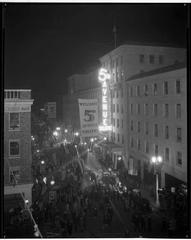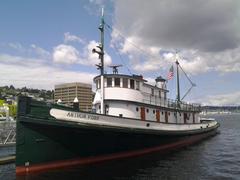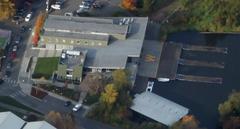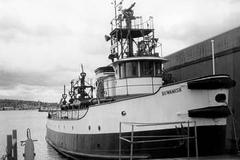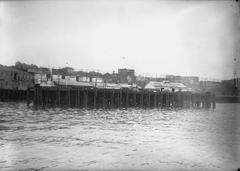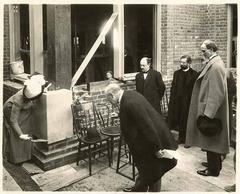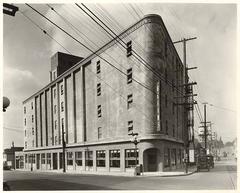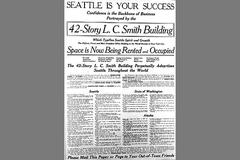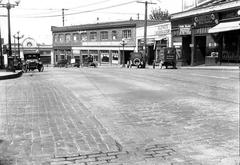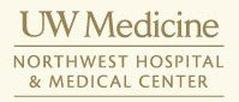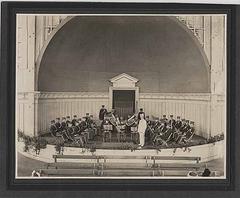
Rainier Tower Seattle: Visiting Hours, Tickets, and Complete Tourist Guide
Date: 03/07/2025
Introduction: Rainier Tower at the Heart of Seattle
Rainier Tower rises as one of Seattle’s most distinctive architectural icons, instantly recognizable for its daring inverted pedestal base. Designed by Minoru Yamasaki, the visionary architect behind the original World Trade Center, this 41-story office tower graces downtown Seattle’s Metropolitan Tract—a historically significant parcel originally owned by the University of Washington. The tower’s unique “wine glass stem” base, elevating the structure above an open plaza, is both an engineering marvel and a symbol of the city’s forward-thinking urban spirit.
Rainier Tower is more than just an office building. Its plaza and connected Rainier Square development invite visitors to engage with contemporary Seattle while honoring the area’s rich history. Located at 1301 Fifth Avenue and integrated seamlessly with Seattle’s extensive public transit network, Rainier Tower offers an accessible and memorable stop for architecture lovers, tourists, and locals alike. For the most current updates and events, consult the official resources at archjourney.org and Rainier Square About.
Contents
- Discover Rainier Tower: Seattle’s Architectural Marvel
- Visitor Information: Hours, Tickets, and Accessibility
- Historical and Architectural Highlights
- Origins and Context
- Vision and Design
- Structural Engineering
- Cultural Impact
- Rainier Square Integration and Downtown Revitalization
- Sustainability and Urban Innovation
- Tips for Visitors
- Nearby Attractions
- FAQ
- Visual Media and Interactive Resources
- Conclusion and Recommendations
- Sources
Discover Rainier Tower: Seattle’s Architectural Marvel
Standing at 1301 Fifth Avenue, Rainier Tower is a must-see for anyone drawn to modern architecture and vibrant cityscapes. Its 11-story pedestal base, narrowing dramatically before supporting the soaring office floors above, sets it apart in the Seattle skyline. The surrounding plaza and retail spaces are open to the public, making Rainier Tower accessible and inviting for all.
Visitor Information: Hours, Tickets, and Accessibility
Visiting Hours:
- The plaza and retail concourse are generally open Monday through Friday, 8:00 AM to 6:00 PM.
- Outdoor areas are accessible daily, typically from early morning to late evening.
- Special events may extend these hours; check event calendars for details.
Tickets:
- No tickets are required to visit the public spaces and plaza.
- Office floors and private areas remain restricted to tenants and authorized guests.
Accessibility:
- The plaza, concourse, and all public areas are fully ADA-compliant, with ramps, elevators, and accessible restrooms.
- Service animals are welcome.
Getting There:
- Easily accessible via multiple bus lines, the Seattle Center Monorail, and the nearby Link Light Rail stations.
- On-site parking is available at the Rainier Square garage; secure bike lockers and shower facilities support sustainable commuting.
- For up-to-date transit directions, see the Metropolitan Tract website.
Historical and Architectural Highlights
Origins and Context
Rainier Tower occupies land central to Seattle’s history: the Metropolitan Tract, once home to the University of Washington’s original campus. The tower was built between 1972 and 1977 by UNICO Properties and originally named for Rainier Bank, reflecting the era’s trend of corporate-sponsored skyscrapers. In 1995, the building regained its Rainier Tower name, a nod to its original identity and local legacy.
Vision and Design
Minoru Yamasaki’s design philosophy shines through in Rainier Tower’s bold pedestal, which elevates the office floors and creates a vibrant pedestrian plaza at street level. The 11-story, 37-meter-tall base maximizes open public space, a concept that contrasted sharply with the shadowed, dense streetscapes of traditional high-rises. The tower’s steel frame is clad in aluminum, giving it a sleek, modernist profile.
Structural Engineering
The tower’s narrow base prompted questions about its stability, especially in a seismically active city like Seattle. Advanced engineering solutions, including a steel frame weighing 5,500 tons, ensure Rainier Tower’s resilience against earthquakes and severe weather. The result is both an architectural statement and a testament to modern structural innovation.
Cultural Impact
Locally dubbed the “Beaver Building” or “golf tee” due to its unusual base, Rainier Tower has become a beloved—and sometimes debated—Seattle landmark. It remains a favorite subject among artists and photographers and frequently appears in local walking tours and city guides (archjourney.org, seattle.urbansketchers.org).
Rainier Square Integration and Downtown Revitalization
Rainier Tower anchors the Rainier Square development, a mixed-use project that has transformed the surrounding downtown blocks. The new 58-story Rainier Square Tower, completed in the early 2020s, was designed with a sloped east façade to preserve views of Rainier Tower’s iconic base. The development includes luxury residences, high-end offices, retail, and dining, creating a lively, mixed-use urban hub (Rainier Square About, Lewis Builds).
Sustainability and Urban Innovation
Rainier Square reflects Seattle’s leadership in urban sustainability. Key initiatives include:
- Use of renewable hydropower, with Seattle City Light providing 90% clean energy (Lindsay Angelo).
- Energy-efficient HVAC, elevators, and security systems.
- The pioneering “speedcore” modular steel-plate core construction method, which expedited building and reduced carbon emissions (Lewis Builds).
- Extensive bike facilities and green landscaping that supports urban ecology.
Tips for Visitors
- Best Time to Visit: Daylight hours provide the best lighting for photography and a chance to experience the plaza’s landscaping.
- Photography: Capture the tower’s base from Union Street and 5th Avenue, or from the plaza itself. Early morning and late afternoon often offer optimal light.
- Events: The plaza sometimes hosts outdoor film screenings, art installations, and pop-up markets—check local listings for upcoming activities.
- Weather: Seattle weather is unpredictable; pack a rain jacket or umbrella. The underground concourse connects to neighboring buildings for sheltered passage.
- Security: Security staff are present, and visitors may be required to check in if accessing beyond public areas.
Nearby Attractions
Take advantage of Rainier Tower’s central location to explore:
- Pike Place Market: Seattle’s historic market and food destination.
- Seattle Art Museum: A short walk away, featuring world-class exhibitions.
- Pioneer Square: The city’s oldest neighborhood, with unique architecture and museums.
- Seattle Public Library: Celebrated for its modern design.
- Seattle Underground Tour: Discover Seattle’s hidden subterranean history.
More information about local attractions can be found at the Metropolitan Tract website.
FAQ
Q: Can I go inside Rainier Tower?
A: Public access is limited to the lobby, retail concourse, and plaza. Office floors are private.
Q: Are there tickets or fees to visit?
A: No, access to the public areas is free.
Q: Does Rainier Tower have an observation deck?
A: No public observation deck is available. The best views are from the surrounding plaza and streets.
Q: Is the area wheelchair accessible?
A: Yes, all public areas are ADA-compliant.
Q: How do I reach Rainier Tower by public transit?
A: Multiple bus and light rail lines serve downtown Seattle, with stops near the tower.
Q: Are there guided tours?
A: Official tours inside Rainier Tower are not offered, but local architecture tours often include the building as a highlight.
Visual Media and Interactive Resources
Enhance your visit with:
- High-resolution images of Rainier Tower’s base and plaza (use alt text like “Rainier Tower unique pedestal base in Seattle”).
- Interactive walking maps linking Rainier Tower, Rainier Square, and nearby sites.
- Virtual tours or 360-degree photos available via local tourism websites.
- Audio tours through the Audiala app for self-guided exploration.
Conclusion and Visitor Recommendations
Rainier Tower exemplifies Seattle’s blend of architectural innovation, urban revitalization, and community engagement. Its soaring structure, dramatic pedestal, and integration within the dynamic Rainier Square development create a compelling destination for visitors and locals alike. Plan your visit to coincide with plaza events or simply enjoy the urban landscape that balances history, sustainability, and modern design.
For more information, event updates, and guided tours, explore the official Metropolitan Tract website, archjourney.org, and Rainier Square About. Download the Audiala app for the latest audio guides and curated walking tours.
Sources and Further Reading
- Rainier Tower Seattle: Visiting Hours, Tickets, History & Architectural Highlights (archjourney.org)
- Rainier Tower Visiting Hours, Tickets & Seattle Historical Sites Guide (archjourney.org)
- Rainier Tower Visiting Hours, Tickets, and Guide to Seattle’s Iconic Architectural Landmark (metropolitantract.com)
- Visiting Rainier Tower and Rainier Square: Hours, Tickets & Exploring Seattle’s Architectural Gems (rainiersquare.com)
- Rainier Square Tower: A Building Like No Other (lewisbuilds.com)
- Future of Seattle: Sustainability and Urban Growth (lindsayangelo.com)
- Rainier Tower Sketches and Local Art (seattle.urbansketchers.org)
- Rainier Tower Visitor Information (gpsmycity.com)
- Rainier Square Getting Around (rainiersquare.com)
- Rainier Square Tower Residence: A Luxurious High-Rise Home (pendulummag.com)

